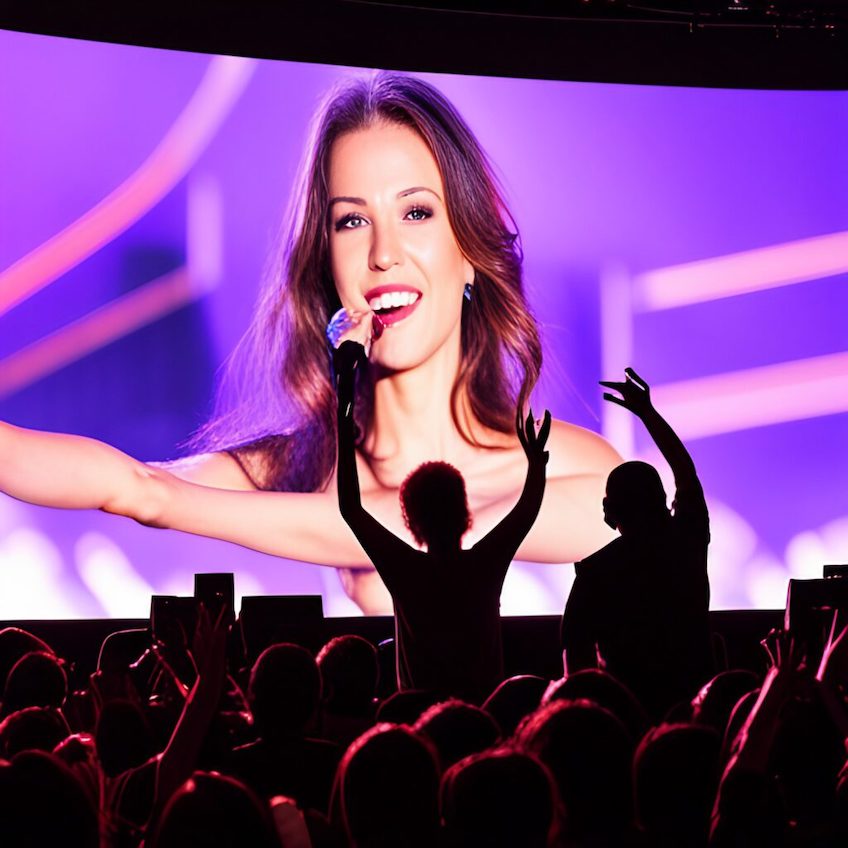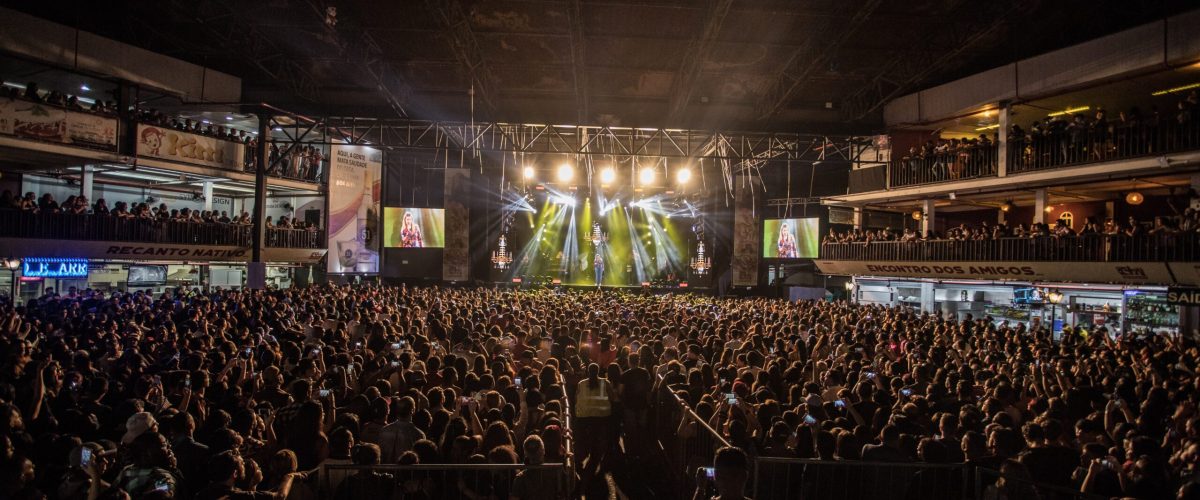Do you want to make your live entertainment events better? One way is using video walls. Video walls can have a huge impact by providing a visually stunning experience and creating a more immersive experience for the audience. The result is a better concert experience and rave reviews for the venue, whether it’s a club, theater, fair, festival or another type of live entertainment event. That means heightened interest in any future event at the venue and lot of social media engagement.
In this article I will address the benefits and issues related to the use of video walls for live music events at your venue. Before we get into the technical side let’s examine the benefits of using video walls as part of any concert production.
Benefits of Using Video Walls for Concerts

Video walls are a great way to create an interactive and immersive experience at festivals. They can be used to highlight the best moments of the festival, add unique visuals and lighting to backdrops or stages, and provide dynamic displays for attendees to interact with. Video walls can also be used in pre-show video sequences or advertisements, providing an engaging way for fans to engage with the festival before it even starts. Additionally, video walls can be used to create a more interactive atmosphere during artist performances, transforming each stage into an immersive experience. They can also be a great way to entice fans to engage as well. Let’s discuss the various ways that video walls are used at concerts and festivals.
Enhancing the Concert Performance:
A video wall can enhance a concert performance by serving as a visually engrossing backdrop the complements the performance and amplifies its impact. Video walls can give performers a larger-than-life feeling and enhance their stage presence. Displaying vivid and dynamic visuals during the performance creates a more immersive experience for fans, enhancing the overall performance. A well-produced concert will use its video wall to integrate video mapping, special effects, stage lighting, animations, graphics, and video sequences to transport the audience to a realm of entrancing sights and sounds. It adds a new dimension to the stage performance, creating an unforgettable and engaging experience for fans and heightens their interest for future events.
Providing Enhanced Viewing:
If you have ever had the opportunity to attend events a large coliseums, stadiums or other large venues, you know that those seats located far from the stage, need binoculars to get a good look at the artists performing. These concert venues provide large video walls so that concert goers can have a better view of the event. These walls are located next to the stage, although some venues supplement them with large monitors located throughout the venue so fans can still stay engaged as they move about the venue.
When attending a concert, location is everything if you want to fully experience the performance. For those of us who love attending concerts, nothing compares to being at the very forefront of the stage, enjoying the music in all its glory. But when it comes to music festivals or large arenas, securing a spot right in front can be a luxury few can afford.
With the use of video walls, concert goers who are located farther from the stage can still feel like they have a front-row view. Video walls allow concert-goers to witness the performance in all its glory, no matter where they are seated. The high-resolution screens create a larger-than-life view of the stage, displaying every detail with razor-sharp clarity. Additionally, with expert video technicians, you can expect seamless transitions and close-up shots, so you never miss a beat.
Acting as a Messaging Channel:
When it comes to messaging concert or festival attendees, video walls are a powerful tool that shouldn’t be overlooked. Not only do they provide a stunning visual display, they also offer an unparalleled opportunity to reach a large audience with targeted messaging. Whether you’re providing scheduling changes, promoting upcoming events, providing wayfinding information, or other information, video walls are able to deliver your message clearly and effectively. This becomes particularly important should an incident occurs that requires the audience to take specific actions, such as evacuating the area. It’s an essential channel as part of an overall communication strategy to reach concert or festival attendees.
Stimulating Audience Engagement:
As concerts and festivals continue to evolve, using video walls for social media engagement has become a crucial tool in enhancing the overall experience for attendees. Not only do video walls provide a captivating visual display, but they also offer an opportunity for concert-goers to stay engaged with their social media accounts by displaying their Tweets and Instagram posts in real-time. Whether it’s a photo of them enjoying the show or a shout-out to their favorite artist, watching their content come to life on the big screen creates a level of excitement and personal connection that can’t be replicated.
Additionally, using video walls has proven to increase social media traffic and engagement, providing an excellent opportunity for venue, fair and festival brands to boost their online presence. With technology continuing to develop and integrate with social media platforms, using video walls is only going to become more prevalent in the concert and festival scene, enhancing the experience for both attendees and performers alike.
Providing Brand Awareness and Sponsorship Opportunities:
Video walls have become a popular way to display sponsor logos, brand promotions, and advertisements at concerts and festivals. These imposing displays can generate millions of impressions throughout the event, making them a highly effective tool for brands to reach new audiences and increase brand awareness. In the fast-paced world of entertainment, event organizers are constantly searching for new and innovative ways to stand out. Video walls have emerged as a game-changing solution, providing a dynamic and engaging platform for sponsors, brand awareness, advertising and generating revenue at concerts and festivals. With their stunning visual displays and flexibility, video walls can easily capture the attention of concert goers and festival attendees, while simultaneously promoting brands and increasing overall revenue. They offer endless possibilities for customization and have the proven ability to successfully convey messages and create impactful advertising campaigns.
Best Practices for Using Videos Walls at Concerts or Festivals
When it comes to concerts, fairs and festivals, video walls can add an impressive visual element that enhances the experience for both the performers and the audience. However, if not used correctly, video walls can quickly become a pitfall for any event. Understanding best practices when using video walls will help you avoid any drawbacks while using them. They using fall under venue issues, technical issues, and content issues.
- Venue Issues: Before using a video wall, it’s imperative that you understand the space issues involved with the venue. How large is the venue? How far will the audience be from the stage? Is it an indoor or outdoor venue? If outdoors, what time of day will the event take place? What other elements are present in space? These factors will come into play when determining the correct size, brightness, pixel pitch, resolution, and power requirements of the video wall you will use for the event.
- Technical Issues: As mentioned above, the space and timing will be factored into the video wall requirements for your event. Let’s examine the technologies involved when using a video wall.
- Pixel Pitch, Viewing Distance and Screen Resolution: Pixel pitch refers to the distance from the center of an LED cluster/pixel to the center of the next LED cluster/pixel, measured in millimeters. The smaller the pixel pitch, the greater the resolution of the screen. The smaller the pitch, the closer you can stand to the screen and still view the content clearly. The higher the pitch, the more distant you must stand to view the content clearly.

With a display surface of a certain size, the smaller the pixel pitch the greater number of pixels that will be displayed. The greater the number of pixels, the higher the resolution and the higher the cost. Fortunately, for most concerts, the audience is not standing next to the screen. A viewing distance of 10 feet means you can use a 4-6 mm pixel width and a viewing distance of 20 feet mans you can use a video wall with a 6-10 pixel width. Knowing the space and how far the audience will be from the video wall will allow you to select the least expensive pixel width wall that provides the resolution you need.
-
-
Image source Brightness Issues: The terms that measure light can be confusing when we discuss the brightness of a video wall. We often use lumens when purchasing light bulbs which describe their total light output. A different term is needed when describing how much light is falling on a particular area. That term is “lux” and is defined as lumen per square meter. It’s an important measurement when using a video projector. since a projector’s light reflects off a surface, the size of that surface affects the brightness of the final image. For example, the image produced by a projector that is projecting onto a 1 square meter screen is ten times brighter than if the same projector – with the same lumen value – is projecting the image onto a 10 square meter screen.
-
Nits is the unit of measure used by LED video walls. It measures the light output per a given surface area. Nits is similar to Lux as it measures light in terms of surface area. However, they have different meanings. Lux represents the quantity of light that is received by surface expressed in lumen per square meter. NIT is a measure of how much light an object emits.
When considering the use of a video wall for a concert, fair, or festival, you need to to know the requirements for brightness. Indoor and outdoor events taking place during daylight hours have a huge difference in the level of brightness required. Direct sunlight can have very negative effects on viewing quality if the brightness isn’t properly set. In a similar vein, if the screen is too bright at night-time or when the lights are turned off, viewers can strain their eyes. Below are the guidelines for determining nit requirements:
-
-
- For Indoor Events: 1,000 – 1,500 nits
- For Outdoor Events Not in Direct Sunlight: 2,000 – 3,000 nits
- Outdoor Events Under Direct Sunlight: 5,000 to as much as 10,000 nits.
-
-
- Technical Capabilities: The adage of garbage in, garbage out is important to remember. Any content that appears on a video wall needs to be optimized for the type of video wall being used. Whether it’s text, images, video or audio, nothing makes a video wall look more unprofessional than low resolution images and content. What may look great on a laptop screen might not convert to the hugeness of video walls. You need to build content with a video wall in mind.
-
- Common Content Issues: Often those designing and preparing content to be displayed on a video wall, do not understand the best practices for the content design. Common mistakes include:
- Content too long: Content too long is a common problem among inexperienced designers or event advertisers. Short and simple should be the guiding principle when designing an effective digital sign. At concerts, people are excited and are dealing with a lot of distractions. They are likely moving about as well during the event. Keep your individual messages short and easily digested. Limiting the length of video wall content to around 10 seconds is thought to be a good rule of thumb.
- Small, Unreadable Content: Remember what looks easily readable on your laptop screen could be very problematic when it comes to reading it on a video wall. Use a sans serif font with letters occupying a fourth of the screen when creating text for a video wall. Remember that most video walls used for concerts do not have the pixel density of a computer screen so be very careful when trying to using text effects such as shadows or other effects. They are much less likely to be visible on a video wall with spaced out pixels.
- Ordering Content Based on Hierarchy: Make sure the order of your visual content makes sense. Always put the most important part of your message at the forefront of what is shown. Make it easy for the viewer to understand your message. Make it the most prolific element on the screen, differentiating it from other screen elements or event repeating it where it makes sense.
Conclusion:
Video walls are an increasingly popular way to enhance live music performances. By providing a stunning visual display, connecting performers with their audience, promoting branding, creating an immersive environment, and providing valuable data analytics reports, video walls have a lot of potential to make a significant difference in your next event, making it an unforgettable experience for all involved. Now that you have a better understanding of how to use video walls, give them a try in your next concert or event to take it to the next level!
Related Posts:
4 Key Audio Specs for Outdoor Concert and Festival Production
Live Event Production: Stage Band Lighting





